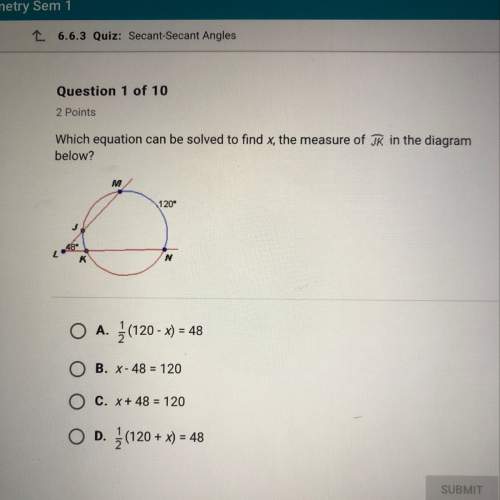
Mathematics, 07.05.2020 05:02 httpcindy14
(a) Show that the parametric equations x = x1 + (x2 − x1)t, y = y1 + (y2 − y1)t where 0 ≤ t ≤ 1, describe the line segment that joins the points P1(x1, y1) and P2(x2, y2). This answer has not been graded yet. (b) Find parametric equations to represent the line segment from (−2, 8) to (3, −2). (Enter your answer as a comma-separated list of equations. Let x and y be in term

Answers: 2


Another question on Mathematics

Mathematics, 21.06.2019 14:00
Brook states that the distance on the line is 4 units. caleb states that the whole line does not have a distance because it continues on forever. vivian states that the line is 6 units long. which distance did brook measure? which distance did vivian measure?
Answers: 1

Mathematics, 21.06.2019 18:50
Find the center and the radius of the circle with the equation: x^2-2x+y^2+4y+1=0?
Answers: 1

Mathematics, 21.06.2019 20:00
Prove that the value of the expression 7^8–7^7+7^6 is divisible by 43.
Answers: 1

Mathematics, 21.06.2019 21:30
Questions 9-10. use the table of educational expenditures to answer the questions. k-12 education expenditures population indiana $9.97 billion 6.6 million illinois $28.54 billion 12.9 million kentucky $6.58 billion 4.4 million michigan $16.85 billion 9.9 million ohio $20.23 billion 11.6million 9. if the amount of k-12 education expenses in indiana were proportional to those in ohio, what would have been the expected value of k-12 expenditures in indiana? (give the answer in billions rounded to the nearest hundredth) 10. use the value of k-12 education expenditures in michigan as a proportion of the population in michigan to estimate what the value of k-12 education expenses would be in illinois. a) find the expected value of k-12 expenditures in illinois if illinois were proportional to michigan. (give the answer in billions rounded to the nearest hundredth) b) how does this compare to the actual value for k-12 expenditures in illinois? (lower, higher, same? )
Answers: 1
You know the right answer?
(a) Show that the parametric equations x = x1 + (x2 − x1)t, y = y1 + (y2 − y1)t where 0 ≤ t ≤ 1, des...
Questions





Mathematics, 19.02.2021 23:10

Mathematics, 19.02.2021 23:10

Mathematics, 19.02.2021 23:10


Mathematics, 19.02.2021 23:10



Mathematics, 19.02.2021 23:10


History, 19.02.2021 23:10

Mathematics, 19.02.2021 23:10

Social Studies, 19.02.2021 23:10

Mathematics, 19.02.2021 23:10


English, 19.02.2021 23:10

Social Studies, 19.02.2021 23:10




